Research Report: Health and Social Care Inquiry on Autism Support
VerifiedAdded on 2023/06/10
|11
|2662
|380
Report
AI Summary
This report provides an inquiry into health and social care concerning the management of conditions in individuals with autism spectrum disorder (ASD). It covers the challenges faced by children with ASD, effective educational methods, and the prevalence of autism. The research question focuses on how health and social support organizations can reduce the impact on the lives of children with ASD through early-stage interventions. The report reviews literature on the difficulties faced by individuals with ASD, the importance of social support, and various intervention methods like applied behavior analysis, relationship development intervention, and sensory education therapy. It also addresses the legal and ethical implications of research in social and healthcare, research designs, and data collection approaches, utilizing a mixed-methods approach with interviews and secondary data analysis. This assignment solution is available on Desklib, a platform offering study tools and solved assignments for students.
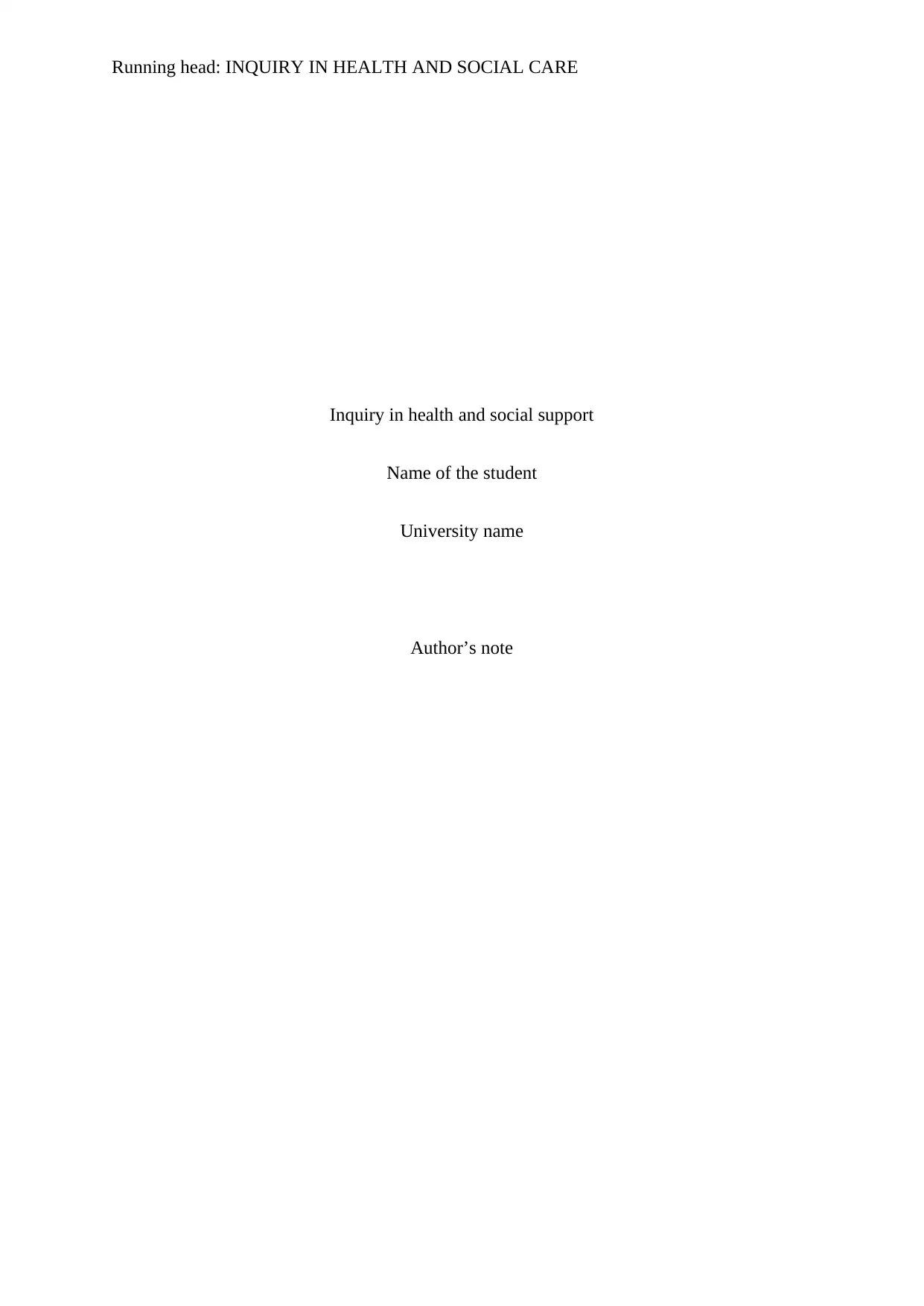
Running head: INQUIRY IN HEALTH AND SOCIAL CARE
Inquiry in health and social support
Name of the student
University name
Author’s note
Inquiry in health and social support
Name of the student
University name
Author’s note
Paraphrase This Document
Need a fresh take? Get an instant paraphrase of this document with our AI Paraphraser
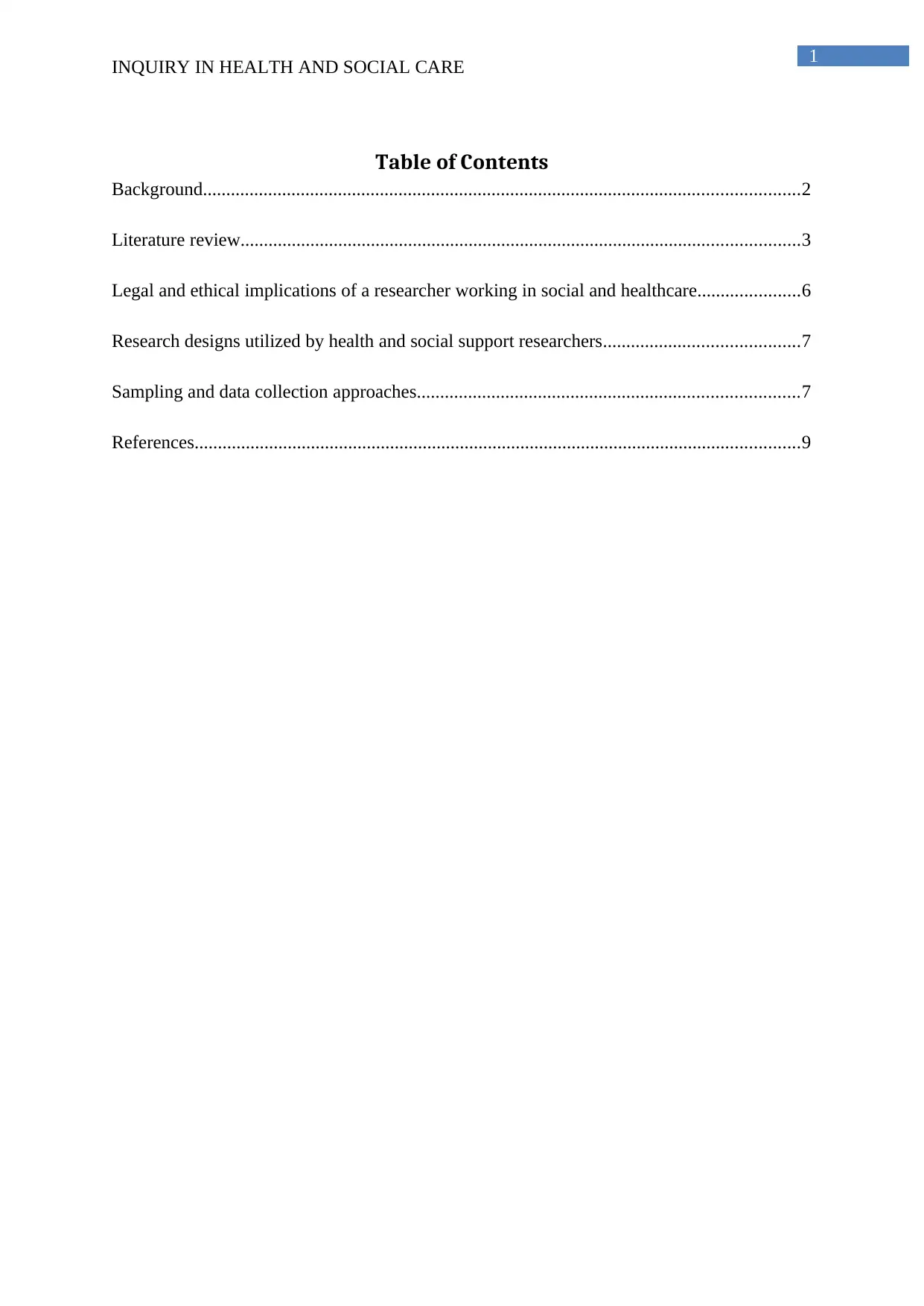
1
INQUIRY IN HEALTH AND SOCIAL CARE
Table of Contents
Background................................................................................................................................2
Literature review........................................................................................................................3
Legal and ethical implications of a researcher working in social and healthcare......................6
Research designs utilized by health and social support researchers..........................................7
Sampling and data collection approaches..................................................................................7
References..................................................................................................................................9
INQUIRY IN HEALTH AND SOCIAL CARE
Table of Contents
Background................................................................................................................................2
Literature review........................................................................................................................3
Legal and ethical implications of a researcher working in social and healthcare......................6
Research designs utilized by health and social support researchers..........................................7
Sampling and data collection approaches..................................................................................7
References..................................................................................................................................9
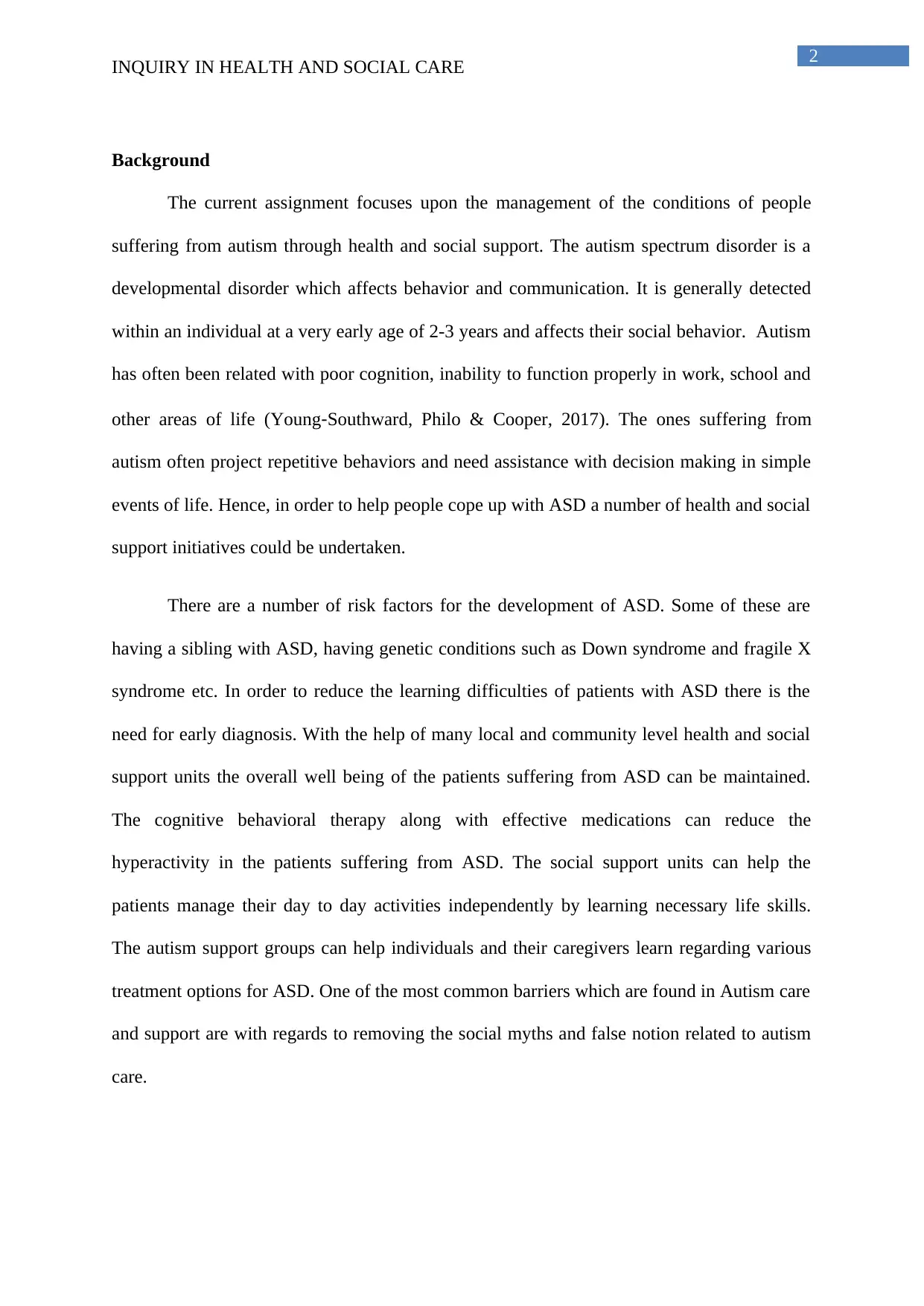
2
INQUIRY IN HEALTH AND SOCIAL CARE
Background
The current assignment focuses upon the management of the conditions of people
suffering from autism through health and social support. The autism spectrum disorder is a
developmental disorder which affects behavior and communication. It is generally detected
within an individual at a very early age of 2-3 years and affects their social behavior. Autism
has often been related with poor cognition, inability to function properly in work, school and
other areas of life (Young‐Southward, Philo & Cooper, 2017). The ones suffering from
autism often project repetitive behaviors and need assistance with decision making in simple
events of life. Hence, in order to help people cope up with ASD a number of health and social
support initiatives could be undertaken.
There are a number of risk factors for the development of ASD. Some of these are
having a sibling with ASD, having genetic conditions such as Down syndrome and fragile X
syndrome etc. In order to reduce the learning difficulties of patients with ASD there is the
need for early diagnosis. With the help of many local and community level health and social
support units the overall well being of the patients suffering from ASD can be maintained.
The cognitive behavioral therapy along with effective medications can reduce the
hyperactivity in the patients suffering from ASD. The social support units can help the
patients manage their day to day activities independently by learning necessary life skills.
The autism support groups can help individuals and their caregivers learn regarding various
treatment options for ASD. One of the most common barriers which are found in Autism care
and support are with regards to removing the social myths and false notion related to autism
care.
INQUIRY IN HEALTH AND SOCIAL CARE
Background
The current assignment focuses upon the management of the conditions of people
suffering from autism through health and social support. The autism spectrum disorder is a
developmental disorder which affects behavior and communication. It is generally detected
within an individual at a very early age of 2-3 years and affects their social behavior. Autism
has often been related with poor cognition, inability to function properly in work, school and
other areas of life (Young‐Southward, Philo & Cooper, 2017). The ones suffering from
autism often project repetitive behaviors and need assistance with decision making in simple
events of life. Hence, in order to help people cope up with ASD a number of health and social
support initiatives could be undertaken.
There are a number of risk factors for the development of ASD. Some of these are
having a sibling with ASD, having genetic conditions such as Down syndrome and fragile X
syndrome etc. In order to reduce the learning difficulties of patients with ASD there is the
need for early diagnosis. With the help of many local and community level health and social
support units the overall well being of the patients suffering from ASD can be maintained.
The cognitive behavioral therapy along with effective medications can reduce the
hyperactivity in the patients suffering from ASD. The social support units can help the
patients manage their day to day activities independently by learning necessary life skills.
The autism support groups can help individuals and their caregivers learn regarding various
treatment options for ASD. One of the most common barriers which are found in Autism care
and support are with regards to removing the social myths and false notion related to autism
care.
⊘ This is a preview!⊘
Do you want full access?
Subscribe today to unlock all pages.

Trusted by 1+ million students worldwide
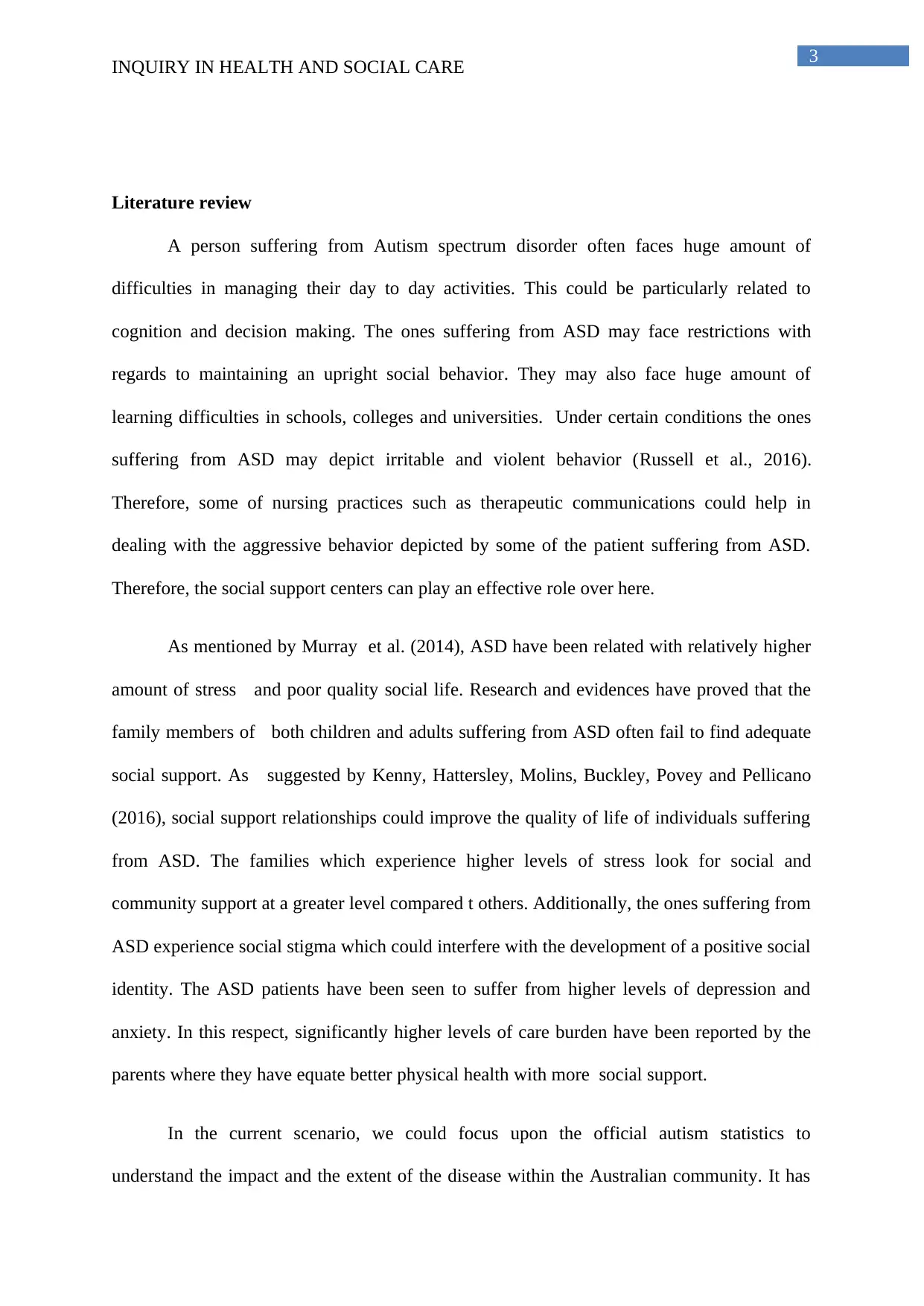
3
INQUIRY IN HEALTH AND SOCIAL CARE
Literature review
A person suffering from Autism spectrum disorder often faces huge amount of
difficulties in managing their day to day activities. This could be particularly related to
cognition and decision making. The ones suffering from ASD may face restrictions with
regards to maintaining an upright social behavior. They may also face huge amount of
learning difficulties in schools, colleges and universities. Under certain conditions the ones
suffering from ASD may depict irritable and violent behavior (Russell et al., 2016).
Therefore, some of nursing practices such as therapeutic communications could help in
dealing with the aggressive behavior depicted by some of the patient suffering from ASD.
Therefore, the social support centers can play an effective role over here.
As mentioned by Murray et al. (2014), ASD have been related with relatively higher
amount of stress and poor quality social life. Research and evidences have proved that the
family members of both children and adults suffering from ASD often fail to find adequate
social support. As suggested by Kenny, Hattersley, Molins, Buckley, Povey and Pellicano
(2016), social support relationships could improve the quality of life of individuals suffering
from ASD. The families which experience higher levels of stress look for social and
community support at a greater level compared t others. Additionally, the ones suffering from
ASD experience social stigma which could interfere with the development of a positive social
identity. The ASD patients have been seen to suffer from higher levels of depression and
anxiety. In this respect, significantly higher levels of care burden have been reported by the
parents where they have equate better physical health with more social support.
In the current scenario, we could focus upon the official autism statistics to
understand the impact and the extent of the disease within the Australian community. It has
INQUIRY IN HEALTH AND SOCIAL CARE
Literature review
A person suffering from Autism spectrum disorder often faces huge amount of
difficulties in managing their day to day activities. This could be particularly related to
cognition and decision making. The ones suffering from ASD may face restrictions with
regards to maintaining an upright social behavior. They may also face huge amount of
learning difficulties in schools, colleges and universities. Under certain conditions the ones
suffering from ASD may depict irritable and violent behavior (Russell et al., 2016).
Therefore, some of nursing practices such as therapeutic communications could help in
dealing with the aggressive behavior depicted by some of the patient suffering from ASD.
Therefore, the social support centers can play an effective role over here.
As mentioned by Murray et al. (2014), ASD have been related with relatively higher
amount of stress and poor quality social life. Research and evidences have proved that the
family members of both children and adults suffering from ASD often fail to find adequate
social support. As suggested by Kenny, Hattersley, Molins, Buckley, Povey and Pellicano
(2016), social support relationships could improve the quality of life of individuals suffering
from ASD. The families which experience higher levels of stress look for social and
community support at a greater level compared t others. Additionally, the ones suffering from
ASD experience social stigma which could interfere with the development of a positive social
identity. The ASD patients have been seen to suffer from higher levels of depression and
anxiety. In this respect, significantly higher levels of care burden have been reported by the
parents where they have equate better physical health with more social support.
In the current scenario, we could focus upon the official autism statistics to
understand the impact and the extent of the disease within the Australian community. It has
Paraphrase This Document
Need a fresh take? Get an instant paraphrase of this document with our AI Paraphraser
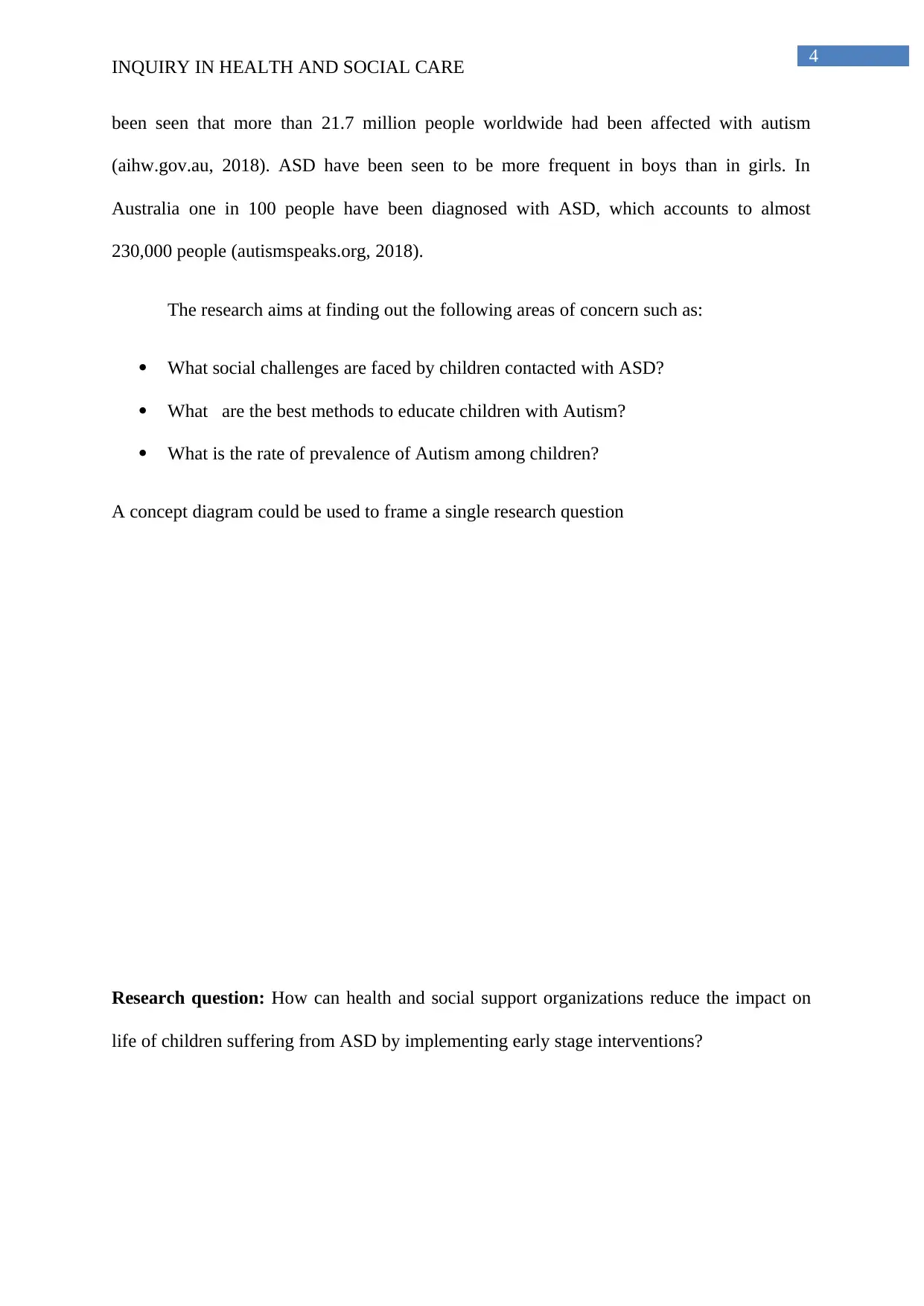
4
INQUIRY IN HEALTH AND SOCIAL CARE
been seen that more than 21.7 million people worldwide had been affected with autism
(aihw.gov.au, 2018). ASD have been seen to be more frequent in boys than in girls. In
Australia one in 100 people have been diagnosed with ASD, which accounts to almost
230,000 people (autismspeaks.org, 2018).
The research aims at finding out the following areas of concern such as:
What social challenges are faced by children contacted with ASD?
What are the best methods to educate children with Autism?
What is the rate of prevalence of Autism among children?
A concept diagram could be used to frame a single research question
Research question: How can health and social support organizations reduce the impact on
life of children suffering from ASD by implementing early stage interventions?
1.Areaofinterest:Autismspectrumdisorder2.Context:ManagementoftheconditionsofthepeoplesufferingfromAutismthroughhealthandsocialsupport3.Target:Tofindoutthebestpossibleinterventionstoeducatechildrenwithautism4.Who&why:Childrenwithautismoftenfacedifficultiesinlearningatprimaryschoollevel5.Relationship:TheeffectofearlyinterventionsonqualityoflifeinAutism
INQUIRY IN HEALTH AND SOCIAL CARE
been seen that more than 21.7 million people worldwide had been affected with autism
(aihw.gov.au, 2018). ASD have been seen to be more frequent in boys than in girls. In
Australia one in 100 people have been diagnosed with ASD, which accounts to almost
230,000 people (autismspeaks.org, 2018).
The research aims at finding out the following areas of concern such as:
What social challenges are faced by children contacted with ASD?
What are the best methods to educate children with Autism?
What is the rate of prevalence of Autism among children?
A concept diagram could be used to frame a single research question
Research question: How can health and social support organizations reduce the impact on
life of children suffering from ASD by implementing early stage interventions?
1.Areaofinterest:Autismspectrumdisorder2.Context:ManagementoftheconditionsofthepeoplesufferingfromAutismthroughhealthandsocialsupport3.Target:Tofindoutthebestpossibleinterventionstoeducatechildrenwithautism4.Who&why:Childrenwithautismoftenfacedifficultiesinlearningatprimaryschoollevel5.Relationship:TheeffectofearlyinterventionsonqualityoflifeinAutism
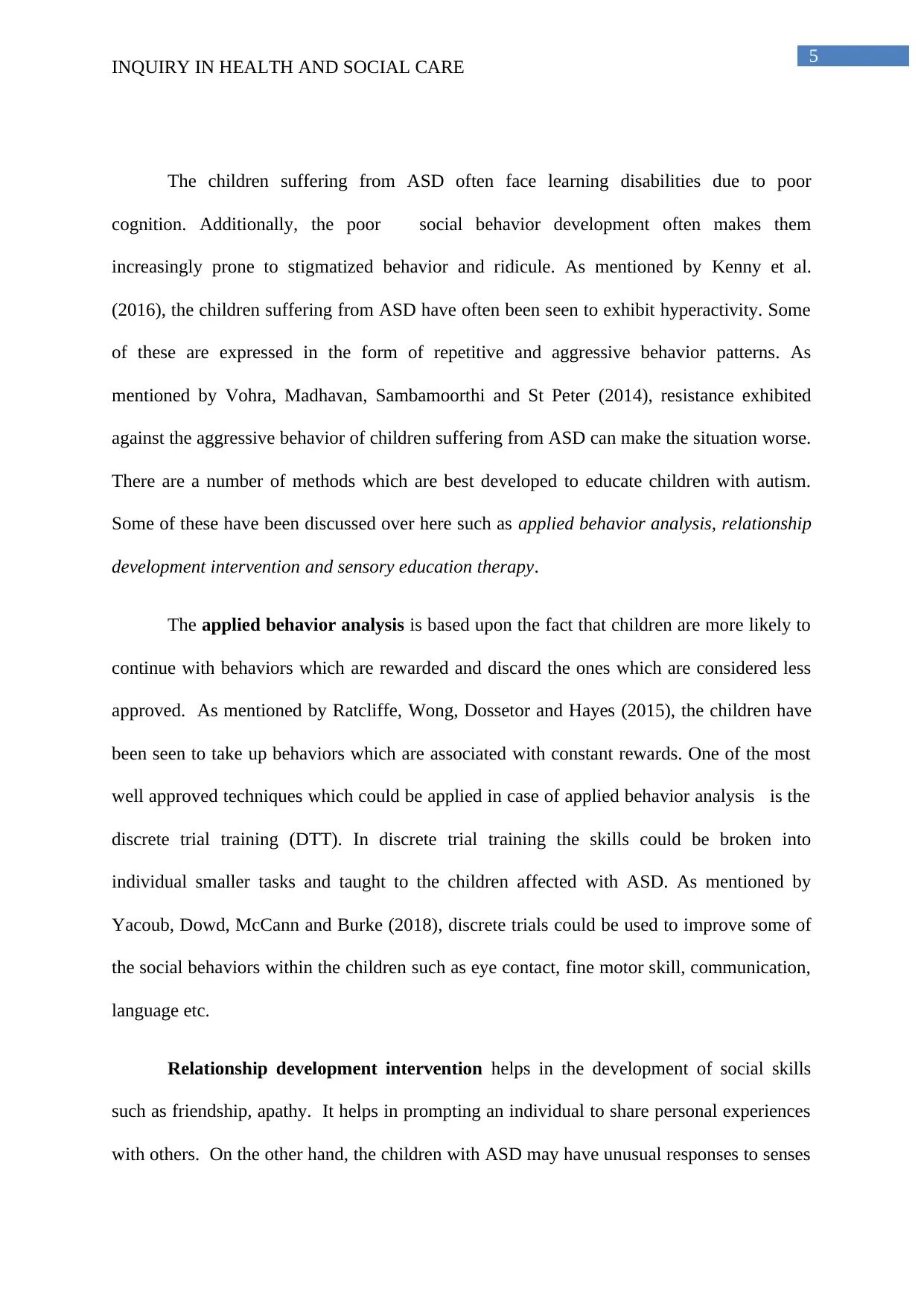
5
INQUIRY IN HEALTH AND SOCIAL CARE
The children suffering from ASD often face learning disabilities due to poor
cognition. Additionally, the poor social behavior development often makes them
increasingly prone to stigmatized behavior and ridicule. As mentioned by Kenny et al.
(2016), the children suffering from ASD have often been seen to exhibit hyperactivity. Some
of these are expressed in the form of repetitive and aggressive behavior patterns. As
mentioned by Vohra, Madhavan, Sambamoorthi and St Peter (2014), resistance exhibited
against the aggressive behavior of children suffering from ASD can make the situation worse.
There are a number of methods which are best developed to educate children with autism.
Some of these have been discussed over here such as applied behavior analysis, relationship
development intervention and sensory education therapy.
The applied behavior analysis is based upon the fact that children are more likely to
continue with behaviors which are rewarded and discard the ones which are considered less
approved. As mentioned by Ratcliffe, Wong, Dossetor and Hayes (2015), the children have
been seen to take up behaviors which are associated with constant rewards. One of the most
well approved techniques which could be applied in case of applied behavior analysis is the
discrete trial training (DTT). In discrete trial training the skills could be broken into
individual smaller tasks and taught to the children affected with ASD. As mentioned by
Yacoub, Dowd, McCann and Burke (2018), discrete trials could be used to improve some of
the social behaviors within the children such as eye contact, fine motor skill, communication,
language etc.
Relationship development intervention helps in the development of social skills
such as friendship, apathy. It helps in prompting an individual to share personal experiences
with others. On the other hand, the children with ASD may have unusual responses to senses
INQUIRY IN HEALTH AND SOCIAL CARE
The children suffering from ASD often face learning disabilities due to poor
cognition. Additionally, the poor social behavior development often makes them
increasingly prone to stigmatized behavior and ridicule. As mentioned by Kenny et al.
(2016), the children suffering from ASD have often been seen to exhibit hyperactivity. Some
of these are expressed in the form of repetitive and aggressive behavior patterns. As
mentioned by Vohra, Madhavan, Sambamoorthi and St Peter (2014), resistance exhibited
against the aggressive behavior of children suffering from ASD can make the situation worse.
There are a number of methods which are best developed to educate children with autism.
Some of these have been discussed over here such as applied behavior analysis, relationship
development intervention and sensory education therapy.
The applied behavior analysis is based upon the fact that children are more likely to
continue with behaviors which are rewarded and discard the ones which are considered less
approved. As mentioned by Ratcliffe, Wong, Dossetor and Hayes (2015), the children have
been seen to take up behaviors which are associated with constant rewards. One of the most
well approved techniques which could be applied in case of applied behavior analysis is the
discrete trial training (DTT). In discrete trial training the skills could be broken into
individual smaller tasks and taught to the children affected with ASD. As mentioned by
Yacoub, Dowd, McCann and Burke (2018), discrete trials could be used to improve some of
the social behaviors within the children such as eye contact, fine motor skill, communication,
language etc.
Relationship development intervention helps in the development of social skills
such as friendship, apathy. It helps in prompting an individual to share personal experiences
with others. On the other hand, the children with ASD may have unusual responses to senses
⊘ This is a preview!⊘
Do you want full access?
Subscribe today to unlock all pages.

Trusted by 1+ million students worldwide
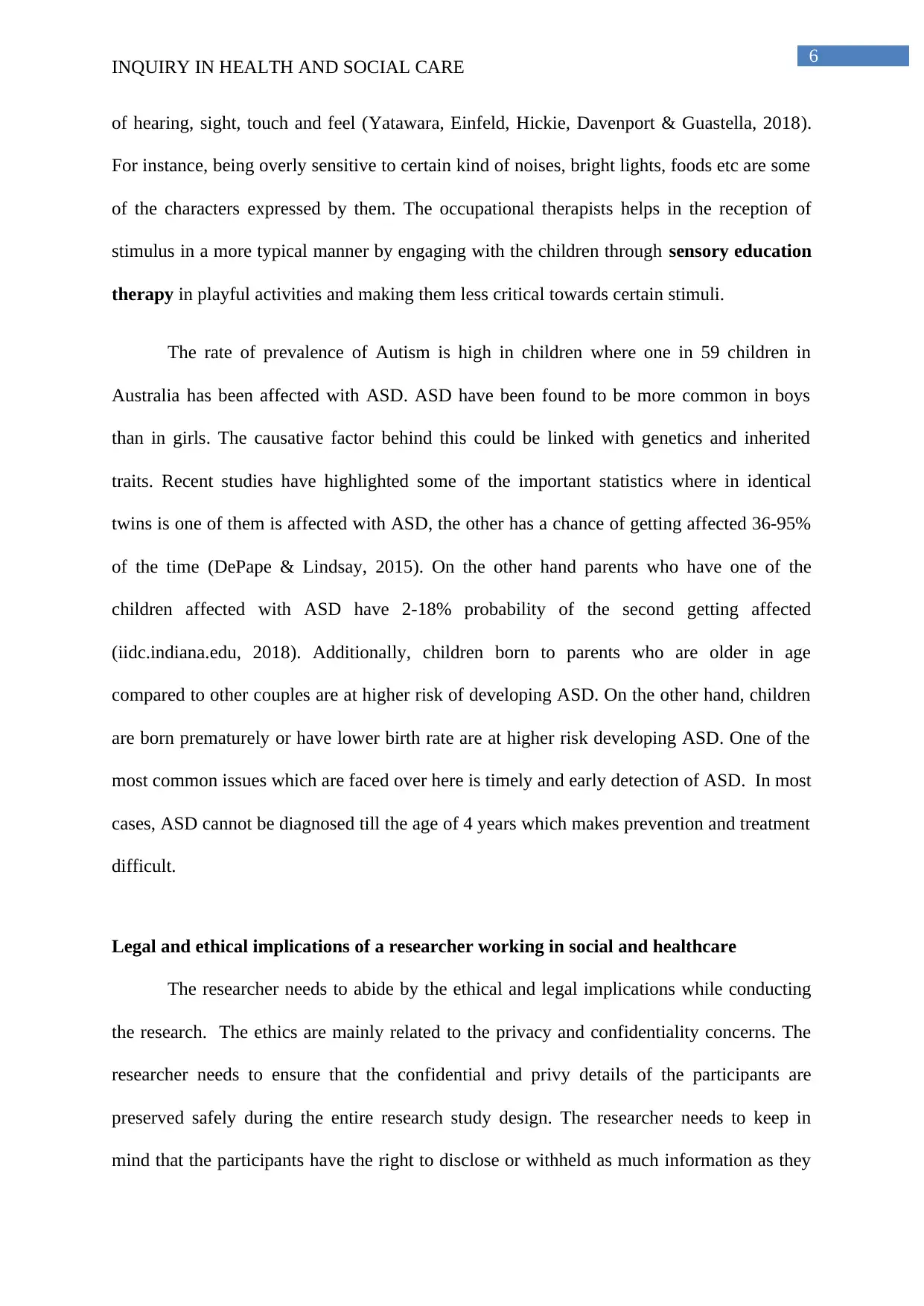
6
INQUIRY IN HEALTH AND SOCIAL CARE
of hearing, sight, touch and feel (Yatawara, Einfeld, Hickie, Davenport & Guastella, 2018).
For instance, being overly sensitive to certain kind of noises, bright lights, foods etc are some
of the characters expressed by them. The occupational therapists helps in the reception of
stimulus in a more typical manner by engaging with the children through sensory education
therapy in playful activities and making them less critical towards certain stimuli.
The rate of prevalence of Autism is high in children where one in 59 children in
Australia has been affected with ASD. ASD have been found to be more common in boys
than in girls. The causative factor behind this could be linked with genetics and inherited
traits. Recent studies have highlighted some of the important statistics where in identical
twins is one of them is affected with ASD, the other has a chance of getting affected 36-95%
of the time (DePape & Lindsay, 2015). On the other hand parents who have one of the
children affected with ASD have 2-18% probability of the second getting affected
(iidc.indiana.edu, 2018). Additionally, children born to parents who are older in age
compared to other couples are at higher risk of developing ASD. On the other hand, children
are born prematurely or have lower birth rate are at higher risk developing ASD. One of the
most common issues which are faced over here is timely and early detection of ASD. In most
cases, ASD cannot be diagnosed till the age of 4 years which makes prevention and treatment
difficult.
Legal and ethical implications of a researcher working in social and healthcare
The researcher needs to abide by the ethical and legal implications while conducting
the research. The ethics are mainly related to the privacy and confidentiality concerns. The
researcher needs to ensure that the confidential and privy details of the participants are
preserved safely during the entire research study design. The researcher needs to keep in
mind that the participants have the right to disclose or withheld as much information as they
INQUIRY IN HEALTH AND SOCIAL CARE
of hearing, sight, touch and feel (Yatawara, Einfeld, Hickie, Davenport & Guastella, 2018).
For instance, being overly sensitive to certain kind of noises, bright lights, foods etc are some
of the characters expressed by them. The occupational therapists helps in the reception of
stimulus in a more typical manner by engaging with the children through sensory education
therapy in playful activities and making them less critical towards certain stimuli.
The rate of prevalence of Autism is high in children where one in 59 children in
Australia has been affected with ASD. ASD have been found to be more common in boys
than in girls. The causative factor behind this could be linked with genetics and inherited
traits. Recent studies have highlighted some of the important statistics where in identical
twins is one of them is affected with ASD, the other has a chance of getting affected 36-95%
of the time (DePape & Lindsay, 2015). On the other hand parents who have one of the
children affected with ASD have 2-18% probability of the second getting affected
(iidc.indiana.edu, 2018). Additionally, children born to parents who are older in age
compared to other couples are at higher risk of developing ASD. On the other hand, children
are born prematurely or have lower birth rate are at higher risk developing ASD. One of the
most common issues which are faced over here is timely and early detection of ASD. In most
cases, ASD cannot be diagnosed till the age of 4 years which makes prevention and treatment
difficult.
Legal and ethical implications of a researcher working in social and healthcare
The researcher needs to abide by the ethical and legal implications while conducting
the research. The ethics are mainly related to the privacy and confidentiality concerns. The
researcher needs to ensure that the confidential and privy details of the participants are
preserved safely during the entire research study design. The researcher needs to keep in
mind that the participants have the right to disclose or withheld as much information as they
Paraphrase This Document
Need a fresh take? Get an instant paraphrase of this document with our AI Paraphraser
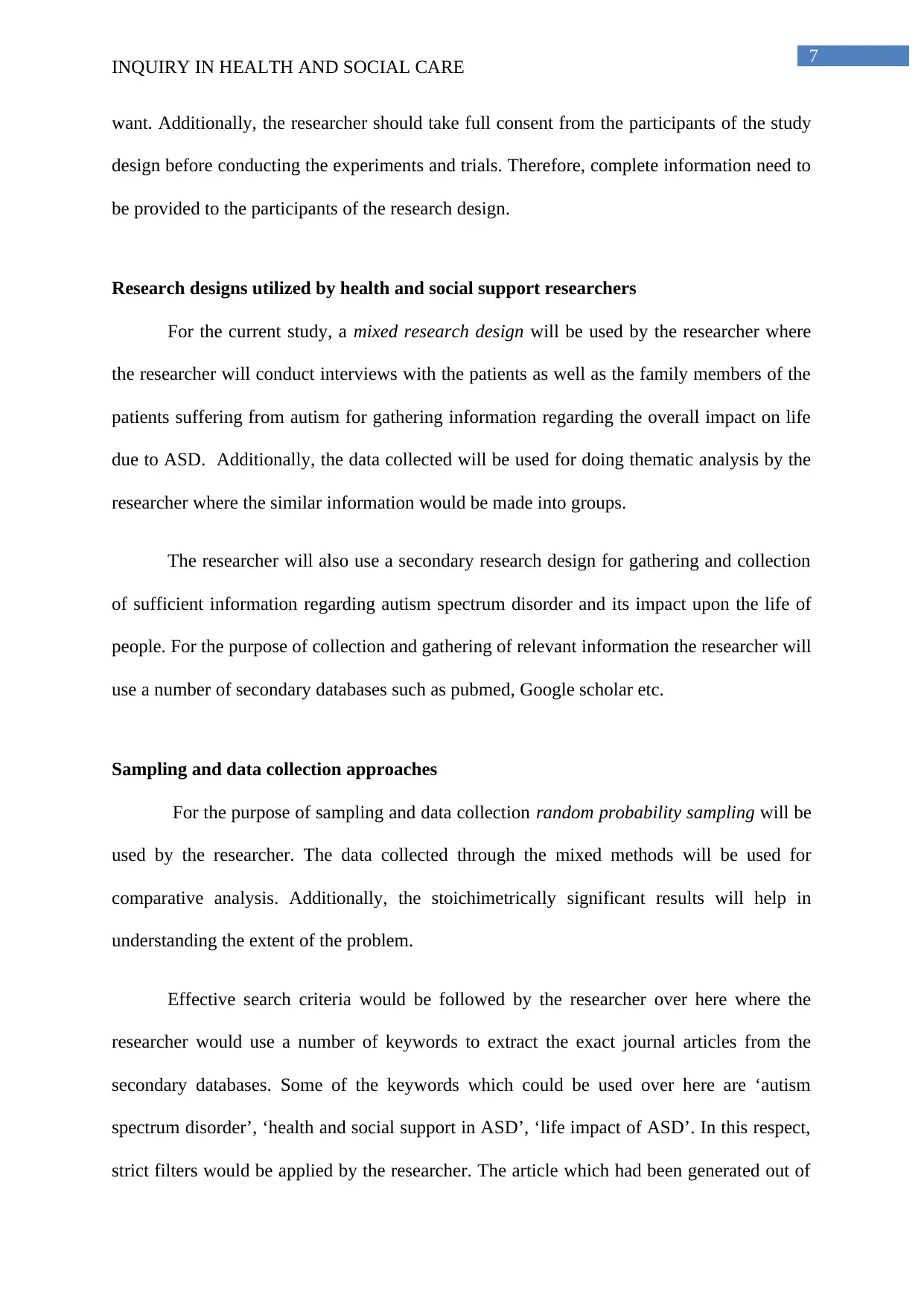
7
INQUIRY IN HEALTH AND SOCIAL CARE
want. Additionally, the researcher should take full consent from the participants of the study
design before conducting the experiments and trials. Therefore, complete information need to
be provided to the participants of the research design.
Research designs utilized by health and social support researchers
For the current study, a mixed research design will be used by the researcher where
the researcher will conduct interviews with the patients as well as the family members of the
patients suffering from autism for gathering information regarding the overall impact on life
due to ASD. Additionally, the data collected will be used for doing thematic analysis by the
researcher where the similar information would be made into groups.
The researcher will also use a secondary research design for gathering and collection
of sufficient information regarding autism spectrum disorder and its impact upon the life of
people. For the purpose of collection and gathering of relevant information the researcher will
use a number of secondary databases such as pubmed, Google scholar etc.
Sampling and data collection approaches
For the purpose of sampling and data collection random probability sampling will be
used by the researcher. The data collected through the mixed methods will be used for
comparative analysis. Additionally, the stoichimetrically significant results will help in
understanding the extent of the problem.
Effective search criteria would be followed by the researcher over here where the
researcher would use a number of keywords to extract the exact journal articles from the
secondary databases. Some of the keywords which could be used over here are ‘autism
spectrum disorder’, ‘health and social support in ASD’, ‘life impact of ASD’. In this respect,
strict filters would be applied by the researcher. The article which had been generated out of
INQUIRY IN HEALTH AND SOCIAL CARE
want. Additionally, the researcher should take full consent from the participants of the study
design before conducting the experiments and trials. Therefore, complete information need to
be provided to the participants of the research design.
Research designs utilized by health and social support researchers
For the current study, a mixed research design will be used by the researcher where
the researcher will conduct interviews with the patients as well as the family members of the
patients suffering from autism for gathering information regarding the overall impact on life
due to ASD. Additionally, the data collected will be used for doing thematic analysis by the
researcher where the similar information would be made into groups.
The researcher will also use a secondary research design for gathering and collection
of sufficient information regarding autism spectrum disorder and its impact upon the life of
people. For the purpose of collection and gathering of relevant information the researcher will
use a number of secondary databases such as pubmed, Google scholar etc.
Sampling and data collection approaches
For the purpose of sampling and data collection random probability sampling will be
used by the researcher. The data collected through the mixed methods will be used for
comparative analysis. Additionally, the stoichimetrically significant results will help in
understanding the extent of the problem.
Effective search criteria would be followed by the researcher over here where the
researcher would use a number of keywords to extract the exact journal articles from the
secondary databases. Some of the keywords which could be used over here are ‘autism
spectrum disorder’, ‘health and social support in ASD’, ‘life impact of ASD’. In this respect,
strict filters would be applied by the researcher. The article which had been generated out of

8
INQUIRY IN HEALTH AND SOCIAL CARE
the exact list of keywords used would not be taken into consideration. Additionally, only the
articles printed in English would be taken into consideration, any other vernacular will be
eliminated. The article within the bracket of the last 10-12 years only would be taken into
consideration.
INQUIRY IN HEALTH AND SOCIAL CARE
the exact list of keywords used would not be taken into consideration. Additionally, only the
articles printed in English would be taken into consideration, any other vernacular will be
eliminated. The article within the bracket of the last 10-12 years only would be taken into
consideration.
⊘ This is a preview!⊘
Do you want full access?
Subscribe today to unlock all pages.

Trusted by 1+ million students worldwide
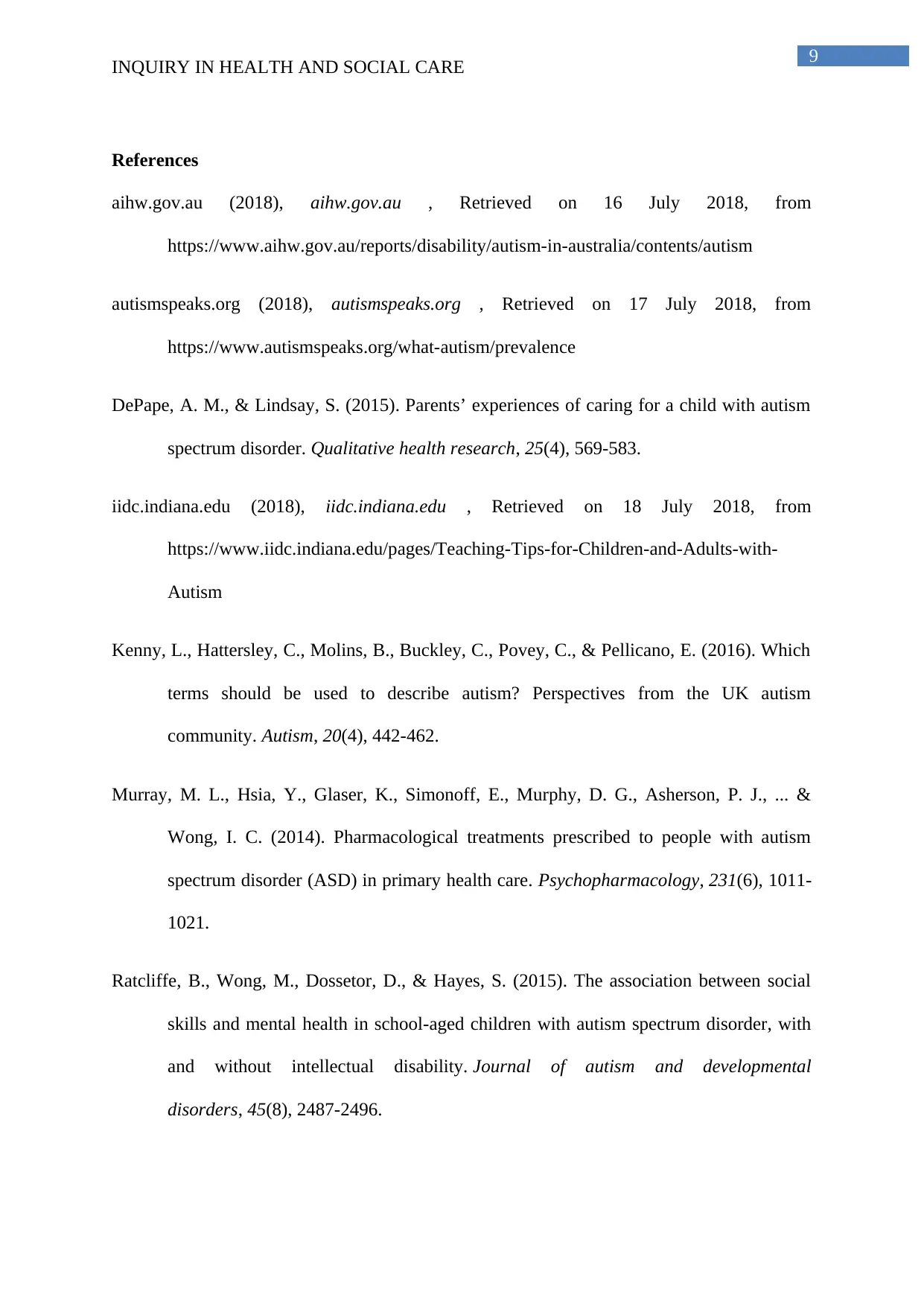
9
INQUIRY IN HEALTH AND SOCIAL CARE
References
aihw.gov.au (2018), aihw.gov.au , Retrieved on 16 July 2018, from
https://www.aihw.gov.au/reports/disability/autism-in-australia/contents/autism
autismspeaks.org (2018), autismspeaks.org , Retrieved on 17 July 2018, from
https://www.autismspeaks.org/what-autism/prevalence
DePape, A. M., & Lindsay, S. (2015). Parents’ experiences of caring for a child with autism
spectrum disorder. Qualitative health research, 25(4), 569-583.
iidc.indiana.edu (2018), iidc.indiana.edu , Retrieved on 18 July 2018, from
https://www.iidc.indiana.edu/pages/Teaching-Tips-for-Children-and-Adults-with-
Autism
Kenny, L., Hattersley, C., Molins, B., Buckley, C., Povey, C., & Pellicano, E. (2016). Which
terms should be used to describe autism? Perspectives from the UK autism
community. Autism, 20(4), 442-462.
Murray, M. L., Hsia, Y., Glaser, K., Simonoff, E., Murphy, D. G., Asherson, P. J., ... &
Wong, I. C. (2014). Pharmacological treatments prescribed to people with autism
spectrum disorder (ASD) in primary health care. Psychopharmacology, 231(6), 1011-
1021.
Ratcliffe, B., Wong, M., Dossetor, D., & Hayes, S. (2015). The association between social
skills and mental health in school-aged children with autism spectrum disorder, with
and without intellectual disability. Journal of autism and developmental
disorders, 45(8), 2487-2496.
INQUIRY IN HEALTH AND SOCIAL CARE
References
aihw.gov.au (2018), aihw.gov.au , Retrieved on 16 July 2018, from
https://www.aihw.gov.au/reports/disability/autism-in-australia/contents/autism
autismspeaks.org (2018), autismspeaks.org , Retrieved on 17 July 2018, from
https://www.autismspeaks.org/what-autism/prevalence
DePape, A. M., & Lindsay, S. (2015). Parents’ experiences of caring for a child with autism
spectrum disorder. Qualitative health research, 25(4), 569-583.
iidc.indiana.edu (2018), iidc.indiana.edu , Retrieved on 18 July 2018, from
https://www.iidc.indiana.edu/pages/Teaching-Tips-for-Children-and-Adults-with-
Autism
Kenny, L., Hattersley, C., Molins, B., Buckley, C., Povey, C., & Pellicano, E. (2016). Which
terms should be used to describe autism? Perspectives from the UK autism
community. Autism, 20(4), 442-462.
Murray, M. L., Hsia, Y., Glaser, K., Simonoff, E., Murphy, D. G., Asherson, P. J., ... &
Wong, I. C. (2014). Pharmacological treatments prescribed to people with autism
spectrum disorder (ASD) in primary health care. Psychopharmacology, 231(6), 1011-
1021.
Ratcliffe, B., Wong, M., Dossetor, D., & Hayes, S. (2015). The association between social
skills and mental health in school-aged children with autism spectrum disorder, with
and without intellectual disability. Journal of autism and developmental
disorders, 45(8), 2487-2496.
Paraphrase This Document
Need a fresh take? Get an instant paraphrase of this document with our AI Paraphraser
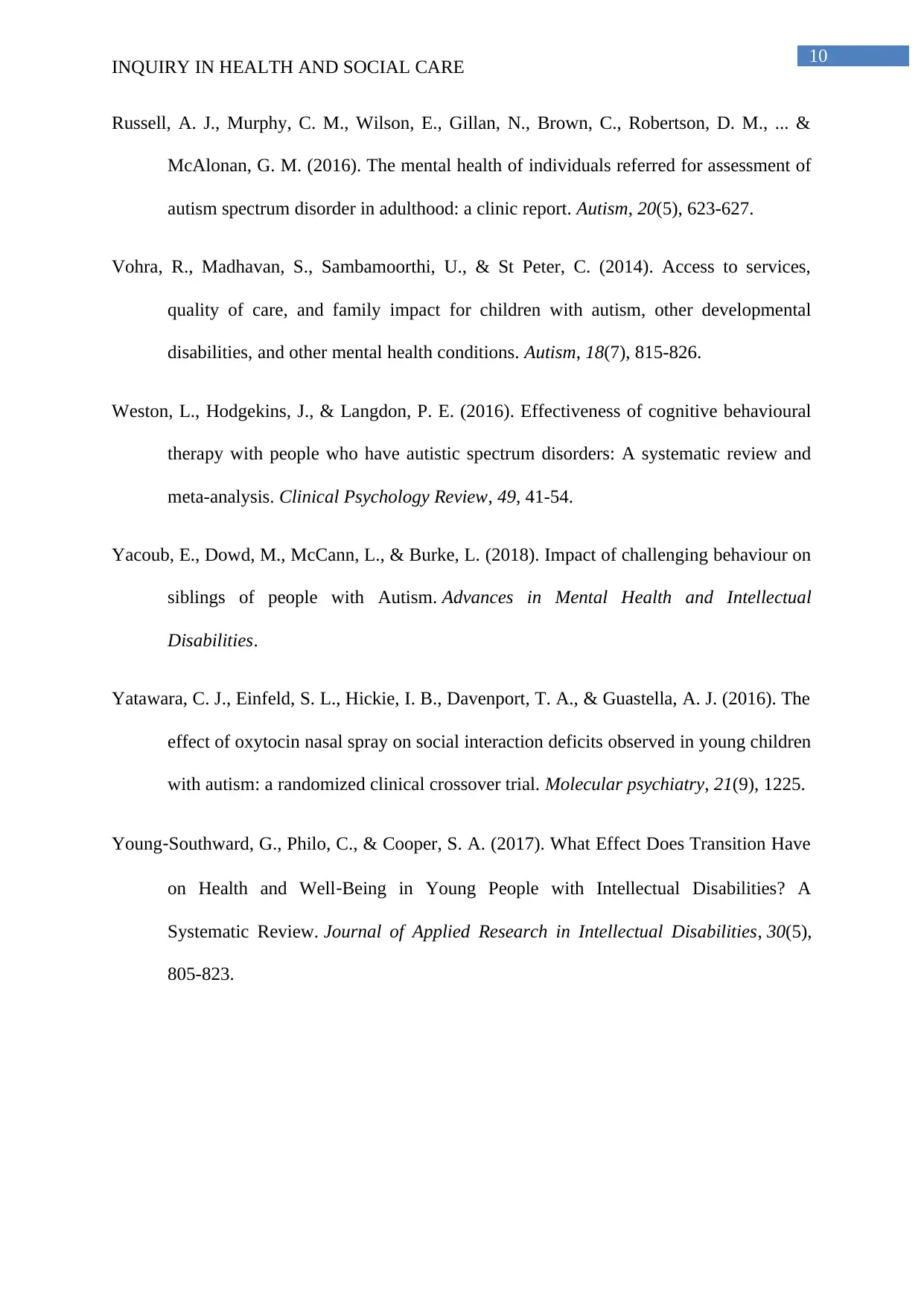
10
INQUIRY IN HEALTH AND SOCIAL CARE
Russell, A. J., Murphy, C. M., Wilson, E., Gillan, N., Brown, C., Robertson, D. M., ... &
McAlonan, G. M. (2016). The mental health of individuals referred for assessment of
autism spectrum disorder in adulthood: a clinic report. Autism, 20(5), 623-627.
Vohra, R., Madhavan, S., Sambamoorthi, U., & St Peter, C. (2014). Access to services,
quality of care, and family impact for children with autism, other developmental
disabilities, and other mental health conditions. Autism, 18(7), 815-826.
Weston, L., Hodgekins, J., & Langdon, P. E. (2016). Effectiveness of cognitive behavioural
therapy with people who have autistic spectrum disorders: A systematic review and
meta-analysis. Clinical Psychology Review, 49, 41-54.
Yacoub, E., Dowd, M., McCann, L., & Burke, L. (2018). Impact of challenging behaviour on
siblings of people with Autism. Advances in Mental Health and Intellectual
Disabilities.
Yatawara, C. J., Einfeld, S. L., Hickie, I. B., Davenport, T. A., & Guastella, A. J. (2016). The
effect of oxytocin nasal spray on social interaction deficits observed in young children
with autism: a randomized clinical crossover trial. Molecular psychiatry, 21(9), 1225.
Young‐Southward, G., Philo, C., & Cooper, S. A. (2017). What Effect Does Transition Have
on Health and Well‐Being in Young People with Intellectual Disabilities? A
Systematic Review. Journal of Applied Research in Intellectual Disabilities, 30(5),
805-823.
INQUIRY IN HEALTH AND SOCIAL CARE
Russell, A. J., Murphy, C. M., Wilson, E., Gillan, N., Brown, C., Robertson, D. M., ... &
McAlonan, G. M. (2016). The mental health of individuals referred for assessment of
autism spectrum disorder in adulthood: a clinic report. Autism, 20(5), 623-627.
Vohra, R., Madhavan, S., Sambamoorthi, U., & St Peter, C. (2014). Access to services,
quality of care, and family impact for children with autism, other developmental
disabilities, and other mental health conditions. Autism, 18(7), 815-826.
Weston, L., Hodgekins, J., & Langdon, P. E. (2016). Effectiveness of cognitive behavioural
therapy with people who have autistic spectrum disorders: A systematic review and
meta-analysis. Clinical Psychology Review, 49, 41-54.
Yacoub, E., Dowd, M., McCann, L., & Burke, L. (2018). Impact of challenging behaviour on
siblings of people with Autism. Advances in Mental Health and Intellectual
Disabilities.
Yatawara, C. J., Einfeld, S. L., Hickie, I. B., Davenport, T. A., & Guastella, A. J. (2016). The
effect of oxytocin nasal spray on social interaction deficits observed in young children
with autism: a randomized clinical crossover trial. Molecular psychiatry, 21(9), 1225.
Young‐Southward, G., Philo, C., & Cooper, S. A. (2017). What Effect Does Transition Have
on Health and Well‐Being in Young People with Intellectual Disabilities? A
Systematic Review. Journal of Applied Research in Intellectual Disabilities, 30(5),
805-823.
1 out of 11
Related Documents
Your All-in-One AI-Powered Toolkit for Academic Success.
+13062052269
info@desklib.com
Available 24*7 on WhatsApp / Email
![[object Object]](/_next/static/media/star-bottom.7253800d.svg)
Unlock your academic potential
Copyright © 2020–2025 A2Z Services. All Rights Reserved. Developed and managed by ZUCOL.




